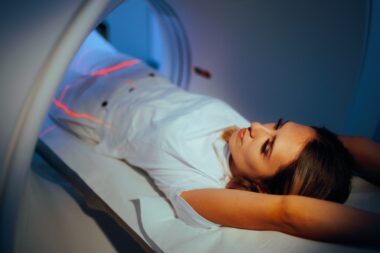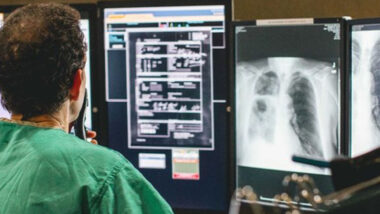Lung cancer is the second-most common cancer affecting both men and women, with approximately 230,000 new cases diagnosed annually. While cancer can be a complex disease to treat, a medical diagnosis of lung cancer does not always mean a poor prognosis. The key to fighting this condition lies in understanding what causes lung cancer and prioritizing early detection, as advances in screening technology and treatment have made it possible to find the disease before it spreads.
Annual lung cancer screening is the most effective method for detecting lung cancer early in individuals who are at high risk. Finding lung cancer early, before it spreads and before symptoms occur, increases the chances of successful treatment and survival. The American Lung Association estimates that lung cancer screening could help save as many as 48,000 lives if the nearly 8 million Americans at high risk got screened. If your provider determines you are at high risk, a simple, non-invasive low-dose CT (LDCT) scan can provide the clarity needed to monitor your lung health and start treatment if necessary.
What is Lung Cancer?
Lung cancer is specifically defined as cancer that originates within your lung tissue. While other types of cancer can spread to the lungs, lung cancer starts there. There are two primary types of lung cancer:
- Non-small cell lung cancer (NSCLC): This type accounts for over 80% of all lung cancers. Common subtypes under NSCLC include large cell carcinoma, adenocarcinoma, and squamous cell carcinoma.
- Small cell lung cancer (SCLC): This type represents about 10% to 15% of lung cancers. SCLC is known to spread more quickly than non-small cell lung cancer.
The Main Causes of Lung Cancer
Although lung cancer can develop for unknown reasons, the primary causes for this disease are environmental and lifestyle factors. Understanding what causes lung cancer is crucial because it helps inform risk reduction strategies and identifies who should seek annual screening.
The largest single cause of lung cancer is tobacco smoking, which is responsible for 80% to 90% of all cases. The risk associated with tobacco use increases with the duration and amount of smoking (measured in pack-years).
Other significant risk factors include:
- Family history of lung cancer: Having a family history of lung cancer can significantly increase an individual’s risk due to genetic predispositions and shared environmental factors.
- Radon exposure: Radon is the second-leading cause of lung cancer, contributing to approximately 21,000 deaths annually.
- Secondhand smoke exposure: Exposure to secondhand smoke from tobacco products increases the risk of lung cancer in non-smokers.
- Exposure to environmental contaminants: This includes exposure to heavy metals, asbestos, and soot in the workplace or other settings.
Quitting smoking, reducing exposure to environmental contaminants and harmful chemicals, and testing home radon levels can decrease your risk for lung cancer.
Who Is at High Risk for Lung Cancer?
Since lung cancer screening is not recommended for everyone (unlike mammograms or colonoscopies), eligibility for annual screening is determined based on specific risk factors, particularly those related to smoking history. If you are a current or former heavy smoker aged 50 or older, you should discuss annual lung cancer screening with your provider.
The U.S. Preventive Services Task Force (USPSTF) recommends annual low-dose CT scans for individuals who meet the following criteria:
- Are 50 to 80 years old and are generally in good health.
- Currently smoke or have quit smoking within the past 15 years.
- Have a 20 pack-year smoking history or more. A pack-year is calculated based on how many packs of cigarettes were smoked on average each day.
The First Signs of Lung Cancer
The most critical aspect of screening is detecting lung cancer early, before symptoms occur. Lung cancer screening aims to find small growths or nodules before the disease has progressed enough to cause noticeable symptoms.
However, when symptoms of cancer affecting the chest area do arise, they may prompt a provider to order a CT scan for diagnosis. General symptoms that might require imaging evaluation include coughing, chest pain, or shortness of breath. If you experience any unexplained symptoms in your chest, unexpected findings from a chest X-ray, or other concerning changes, your provider may order advanced imaging like a CT scan or MRI scan to help make a diagnosis.
Low-Dose CT Lung Cancer Screening: The Gold Standard in Detecting Lung Cancer
Diagnostic imaging plays a crucial role in detecting and assessing lung cancer. A special type of chest CT scan, known as a low-dose lung CT scan (LDCT), is used to help providers diagnose lung cancer in its earliest stages.
How Low-Dose CT Scans Help Detect Lung Cancer Early
The LDCT scan is the most common form of lung cancer screening. This technology uses a very low dose of radiation—less than a typical CT scan—to minimize exposure while capturing highly detailed images. The scan creates a 3D picture of the lungs, capable of detecting small growths called nodules, which may be cancerous (though most nodules are non-cancerous).
Low-dose CT scans are proven to increase survivorship from lung cancer by identifying cancer in its earliest stage. Catching lung cancer at stage 1, when it is localized, can lead to up to a 60% higher chance of survival for patients. Compared to a standard chest X-ray, a CT scan is better at confirming whether a suspicious area in the lungs is a tumor rather than another finding, such as an abscess. Chest X-rays are not as precise as CT scans and may miss early-stage tumors.
LDCT Scans: How They Work
If you are eligible for annual LDCT screening, you will need a referral from a healthcare provider. The procedure is quick and easy and requires no contrast material or special preparation.
- You will typically lie on your back on a table, sometimes with your arms extended overhead.
- The technologist will position you and provide simple instructions.
- The actual scan is very fast, usually taking less than 30 seconds.
- During the scan, you will only need to hold your breath briefly, for about 5 to 10 seconds.
After the procedure, the radiologist will send a report to your referring provider within 24 to 48 hours to discuss your results and any necessary next steps.
Early Detection Saves Lives
The importance of screening cannot be overstated, especially for high-risk individuals. Early detection through a low-dose CT lung cancer screening allows providers to find lung cancer when it is localized (Stage 1). When detected early, treatment is often less invasive and highly successful.
Carolinas Imaging Services (CIS), a joint venture between Charlotte Radiology and Atrium Health, offers convenient, high-quality, and cost-effective outpatient imaging services, including CT lung cancer screening. Our board-certified, subspecialized radiologists are experts in reading complex imaging scans to provide you and your provider with precise and reliable results, putting you on the path to treatment.
If you are determined to be at high risk for lung cancer, do not delay scheduling a low-dose CT scan. Discuss your risk factors with your provider today to determine if lung cancer screening is right for you.



